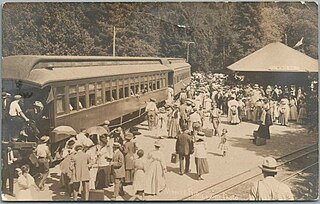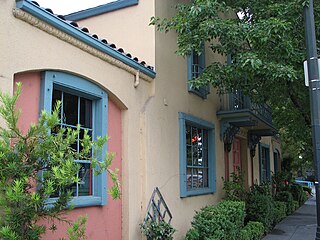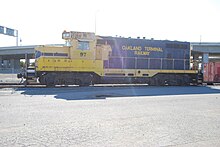
The California Northern Railroad is one of several Class III short-line railroad companies owned by Genesee & Wyoming, Inc. It operates over Southern Pacific Railroad (SP) tracks under a long-term lease.

The Northwestern Pacific Railroad is a 271-mile (436 km) mainline railroad from the ferry connections in Sausalito, California north to Eureka with a connection to the national railroad system at Schellville. The railroad has gone through a history of different ownership and operators but has maintained a generic name of reference as The Northwestern Pacific Railroad, despite no longer being officially named that. Currently, only a 62-mile (100 km) stretch of mainline from Larkspur to the Sonoma County Airport in Windsor and east to Schellville on the “south end” is operated by Sonoma–Marin Area Rail Transit (SMART), which operates both commuter and freight trains with plans for future extension north to Cloverdale. The “north end” from Willits to Eureka is currently out of service, but saved by 2018 legislation to be converted into the Great Redwood Trail.

The Almanor Railroad was a Class III short-line railroad operating in Northern California, USA. It was owned by Collins Pine Company, a division of The Collins Companies and annually hauled approximately 300 carloads of timber and lumber products generated at the mill. The railroad was named after Lake Almanor, which the railroad ran over and adjacent to.

The Richmond Pacific Railroad is a terminal railroad owned by the Levin-Richmond Terminal Corporation. The RPRC operates on 2.5 miles (4.0 km) of track in the shipping terminal and wharves at Richmond, California.

The Central California Traction Company is a Class III short-line railroad operating in the northern San Joaquin Valley, in San Joaquin County, California. It is owned jointly by the Union Pacific and BNSF Railway.

The Pacific Harbor Line was formed in 1998 to take over the Harbor Belt Line (HBL). In 1998, the Alameda Corridor was nearing completion, allowing for a massive amount of railroad traffic from the largest harbors in the Western hemisphere: Port of Los Angeles and Port of Long Beach.

The Modesto and Empire Traction Company is a Class III short-line railroad operating in California's San Joaquin Valley. It is owned by the Beard Land & Investment Company; the Beard family has always owned the railroad. The Beards also created the Beard Industrial Park where the MET's customers are located. The railroad was unique in that it had operated for nearly 50 years exclusively with GE 70-ton switchers built between 1947 and 1955; however, a former Southern Pacific EMD SW1500 switcher was added to the roster as of late. The MET operates on 5 miles (8 km) of mainline track, as well as an additional 48.7 miles (78.4 km) of yard and industry track, providing switching services in the Beard Industrial Park. The MET interchanges with the Union Pacific at Modesto and with the BNSF Railway Stockton Subdivision at Empire.

The Quincy Railroad is a 3.27-mile terminal railroad located at Quincy, California. The QRR interchanges with the Union Pacific at Quincy Junction in Plumas County, California, United States.

The Trona Railway is a 30.5 mi (49.1 km) short-line railroad owned by Searles Valley Minerals. The TRC interchanges with the Lone Pine Subdivision of the Union Pacific Railroad at Searles, California.
The Santa Maria Valley Railroad is a 14.8 miles (23.8 km) shortline railroad that interchanges with the Union Pacific Railroad's Coast Line at Guadalupe, California. As of 2006, the Railroad is owned by the Coast Belle Rail Corporation.

The East Bay Electric Lines were a unit of the Southern Pacific Railroad that operated electric interurban-type trains in the East Bay region of the San Francisco Bay Area. Beginning in 1862, the SP and its predecessors operated local steam-drawn ferry-train passenger service in the East Bay on an expanding system of lines, but in 1902 the Key System started a competing system of electric lines and ferries. The SP then drew up plans to expand and electrify its system of lines and this new service began in 1911. The trains served the cities of Berkeley, Albany, Emeryville, Oakland, Alameda, and San Leandro transporting commuters to and from the large Oakland Pier and SP Alameda Pier. A fleet of ferry boats ran between these piers and the docks of the Ferry Building on the San Francisco Embarcadero.

The Sacramento Northern Railway was a 183-mile (295 km) electric interurban railway that connected Chico in northern California with Oakland via the California capital, Sacramento. In its operation it ran directly on the streets of Oakland, Sacramento, Yuba City, Chico, and Woodland and ran interurban passenger service until 1941 and freight service into the 1960s.

The Tidewater Southern Railway was a short line railroad in Central California in the United States. For most of its history, it was a subsidiary of the Western Pacific Railroad. It was originally built as an interurban system, connecting to the Central California Traction Company, Western Pacific Railroad, Southern Pacific Railroad and Atchison, Topeka and Santa Fe Railway in Stockton, California. Its mainline went southeast from Stockton to Escalon, California and thence to Modesto, California before splitting into two branches ending at the towns of Turlock and Hilmar. Until the mid-1930s, there were plans to extend the line to Fresno and even toward the Los Angeles area. Today, much of the line is still operated by the Union Pacific Railroad. Of all the former interurban railroads in California, the former Tidewater Southern retains the highest percentage of still operating trackage.

The North Pacific Coast Railroad (NPC) was a common carrier 3 ft (914 mm) narrow-gauge steam railroad begun in 1874 and sold in 1902 to new owners who renamed it the North Shore Railroad (California) (NSR) and which rebuilt the southern section into a standard-gauge electric railway.

San Francisco Bay in California has been served by ferries of all types for over 150 years. John Reed established a sailboat ferry service in 1826. Although the construction of the Golden Gate Bridge and the San Francisco–Oakland Bay Bridge led to the decline in the importance of most ferries, some are still in use today for both commuters and tourists.

Petaluma and Santa Rosa Railroad was a 600 volt DC electric interurban railway in Sonoma County, California, United States. It operated between the cities of Petaluma, Sebastopol, Forestville, and Santa Rosa. Company-owned steamboats provided service between Petaluma and San Francisco.
The San Joaquin and Sierra Nevada Railroad was originally built as a 3 ft narrow gauge that ran from Bracks Landing to Woodbridge and Lodi and then east to the Sierra Nevada foothill town of Valley Springs. The railroad was incorporated on March 28, 1882 and construction was completed on April 15, 1885. The railroad was built as a common carrier with copper mining being its primary traffic. The track was built using 35/40 lb steel rails.

The Amador Central Railroad was a standard gauge railroad that operated 11.8 miles (19.0 km) between a connection with the Southern Pacific Company (SP) at Ione and Martell near the town of Jackson, California. The carrier served the Sierra Nevada Foothills gold mining communities and hauled lumber products from the El Dorado National Forest. Amador is the name of the county in which the railroad operated.

The Nevada and Oregon Railroad was an American, 3 ft narrow gauge railroad that operated from Reno, Nevada, then northwest to the California state line near present-day Hallelujah Junction before reaching Oneida, California in 1882. A portion of the route is part of today's Union Pacific Railroad branch connecting their Feather River mainline with Reno. The Nevada and Oregon was incorporated on June 5, 1880, and was headquartered at Reno. It was sold to the Moran Brothers, a group of New York investors, at foreclosure in 1884 and operated unofficially as the Nevada and California Railroad. In 1893 the Moran Brothers sold the railroad and it was reorganized as the Nevada–California–Oregon Railway.

















